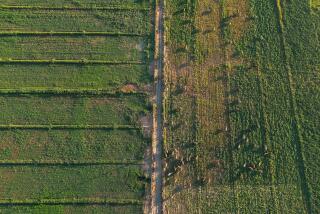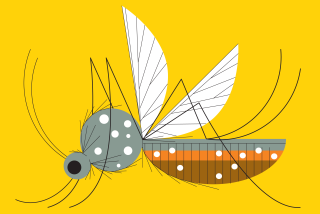Camping: Bites, Itches Aren’t Fun
- Share via
For campers, hikers and walkers, avoiding two scourges of the great outdoors--poisonous plants and insects--can mean the difference between having a great time and being miserable.
Thankfully, there are new and novel ways to avoid and treat poison oak, ivy and sumac and to keep insects at bay.
IvyBlock, a lotion that went on the market in March, is the first drug to be approved by the Food and Drug Administration for protection against poison ivy, oak or sumac. It’s meant to be used before exposure to the poisonous plants. IvyBlock’s active ingredient, quaternium-18 bentonite, is a clay-like substance that’s designed to absorb urushiol, the chemical that causes the allergic reaction, helping to keep it from penetrating the skin.
The lotion should be applied 15 minutes before going outdoors, according to officials at EnviroDerm Pharmaceuticals Inc., the developer and marketer of the product, and then reapplied every four hours. A 4-ounce bottle costs about $12 and is sold at major chain and discount stores. Or, for availability information, call EnviroDerm at (502) 634-7700.
A similar option is Poison Oak-N-Ivy Armor Pre-Exposure Lotion, which works as a temporary barrier, according to a spokeswoman for the manufacturer, Tec Laboratories. The lotion includes tricaprylyl citrate, white mineral oil and beeswax, which together work as a physical barrier to the toxic compounds in the plants.
Like IvyBlock, it should be applied about 15 minutes before exposure and reapplied every four or five hours. A 2-ounce bottle, about $4.99, is sold at chain and independent drug stores and lawn and garden supply stores. Or call Tec Laboratories at (800) ITCHING for distribution information.
What should one do if unprotected exposure occurs?
If a reaction from poisonous plants is severe, seeking medical help is recommended, but for more minor problems, there are options.
“The simplest thing is to wash off your skin,” said Dr. William Epstein, professor of dermatology at UC San Francisco School of Medicine, who said he is developing a product to block reaction to poison oak and ivy. Epstein recommends using rubbing alcohol to rid the skin of the oil. Changing into fresh clothing is also suggested, to reduce exposure to the irritating chemical.
Some products are designed to minimize the damage once exposure occurs. Tec Laboratories’ Tecnu Outdoor Skin Cleanser, with deodorized mineral spirits, is designed to remove the oils that cause the rash, according to a spokesperson for the manufacturer. A 4-ounce bottle is about $4.99.
There also are some new options in the war against insects.
Repello’s Insect Repelling Wristbands, impregnated with 10% DEET (N, N diethyl-m-toluamide) and believed to be the first insect-repelling bands for human use, went on the market last year. The insecticide is activated upon exposure to air, said C.J. Abraham, president and chief executive officer of Repello Products, the manufacturer, and the insecticide is released in vapor form. Each wristband lasts about 130 hours and should be stored in a plastic sandwich bag between uses to prevent exposure to air, Abraham said. One band is normally sufficient, although Abraham recommends slipping an additional band on the ankle if insects are especially plentiful. The bands sell for about $4 per band at chain drug stores and via mail order through Magellan’s, (800) 962-4943.
Another option is Power DEET 25, a pump spray that combines the insecticide (at a concentration of 25%) with natural insect-repelling ingredients such as citronella and peppermint oil. There also are skin softeners and conditioners in the product, manufactured by Tec Labs and introduced last year. A 2-ounce bottle is less than $5.
The federal Environmental Protection Agency, which registers insect repellents, does not have specific guidelines for which concentration of DEET is best, a spokesman said. But a scientific advisory panel met last week to review DEET-containing repellents, he said, and the agency expects to issue a re-registration standard for concentrations to manufacturers within the next two months.
Nor does the California Department of Pesticide Regulation (part of the state Environmental Protection agency) recommend a specific concentration, said a spokesman. But it does offer general recommendations for safe use of insect repellents. Among them: Don’t use repellents over broken or irritated skin. Use them sparingly. Start with a low-concentration product and reapply; it’s better to build up than start with more than is needed. Wash treated skin upon return indoors. Seek medical help if a reaction to repellents is suspected.
For more information on pesticides, consumers can call a toll-free EPA hotline, (800) 858-7378, Monday through Friday, 6:30 a.m. to 4:30 p.m. The hotline is a cooperative project of the EPA and Oregon State University, Corvallis.
The Healthy Traveler appears the second and fourth week of every month.






